How certain clues can help weed out synthetics from natural diamonds
by charlene_voisin | August 1, 2015 9:00 am
By Hemdeep Patel
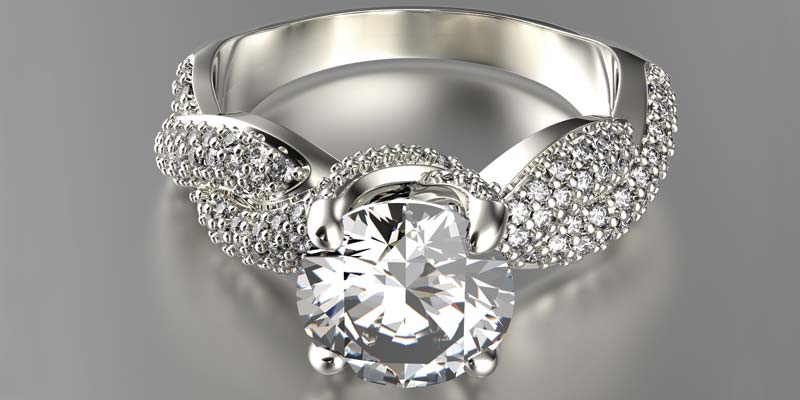 [1]
[1]
The topic of a gemmology column appearing in the December 2011 issue of Jewellery Business centred on the likely probability of undisclosed synthetic diamonds making their way into the diamond pipeline. Barely six months later, International Gemological Institute (IGI) in Antwerp discovered 600 undisclosed synthetics in a parcel of approximately 1000 diamonds ranging in size from .30 points to .70 points.
Though there may have been a sense of relief at finding these stones before they were used in finished jewellery, it was only by chance they ended up at a laboratory. The word in trade circles was the dealer had been unable to sell the goods as a parcel and decided to obtain reports for each diamond for individual sale. Further, reports say his was a cut from a much larger parcel of diamonds. So it can be easily deduced many of the remaining undisclosed stones likely managed to get into the jewellery market and into the hands of unsuspecting consumers.
As this news made its way through the jewellery industry, it served as a wakeup call for manufacturing and trading markets. Companies responded by putting various safeguards in place to protect their inventory and reputation from the possibility of synthetic diamonds making their way into their stock. This mostly took the form of strengthening their internal procedures and consolidating their purchasing to only those manufacturers who were able to assure their diamonds were natural. Other methods included sourcing rough from big-name companies like De Beers or Alrosa or buying diamonds accompanied by reports from reputable laboratories capable of identifying synthetics. In effect, the response to the threat was the traditional ‘know your source’ methodology.
The Canadian gemmological landscape can be broken into two distinct sectors. One is the business of reporting and analyzing gemstones and diamonds, while the second is the appraisal of diamonds, gemstones, and jewellery for the purpose of facilitating or completing a sale. Though many gemmological laboratories in Canada have put into place procedures for screening for synthetics, it is the second sector that can raise concern, given the high-cost equipment needed to identify lab-grown diamonds.
As such, one course of action is to focus on implementing methods to conclusively test for natural diamonds in the colour range of D to L. Despite the fact lab-grown and natural diamonds share identical chemical properties, the key identifying features that separate the two are derived from the differences resulting from where and how crystals are grown.
Growth experience
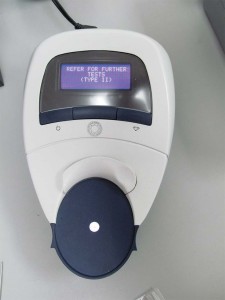 [2]
[2]Natural diamonds are the result of a high-pressure, high-temperature process that began one to three billion years ago about 250 to 300 km below the earth’s crust. Over the course of hundreds of millions of years, the diamonds were delivered to the surface via kimberlite pipes. Lab-grown diamonds, on the other hand, are manufactured within a matter of days in chemically controlled environments through two commercially viable methods: carbon vapour deposition (CVD) or high pressure/high temperature (HPHT).
The geological transformation of a complex chemical soup deep within the earth’s crust into a diamond carbon crystal lattice leaves key clues regarding a stone’s natural origin. These features are imparted onto the stone within three distinct phases of the diamond crystal’s growth. The first point of differentiation occurs during the initial combining of the available elements within the environment, as the carbon lattice structure is formed. The next refers to how the carbon seed sets off the growth of the diamond crystal. And the last occurs as the diamond crystal grows and foreign substances are trapped within the carbon lattice.
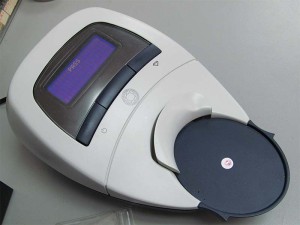 [3]
[3]Two proprietary machines for screening for synthetic diamonds identify the features in the first two phases of growth, that is, the initial chemical environment and the crystal’s growth pattern. The test is very quick, but requires further painstaking analysis of stones it identifies as Type IIa, which are extremely rare in nature and should raise suspicion when found.
However, by examining the differences arising during the three phases of a diamond’s growth, there is a much simpler and inexpensive method to quickly flag the vast majority of natural stones and a large number of lab-growns (whether CVD or HPHT) and therefore leave a relatively small number of diamonds whose origin can be labelled ‘ambiguous.’ It is those ‘unknowns’ that should be referred for further testing at a well-equipped gemmological laboratory to conclusively determine origin.
Revert to type
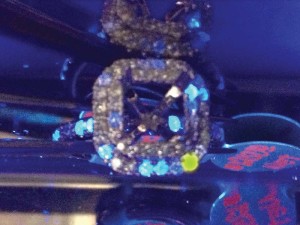 [4]
[4]As noted, the first phase is the chemical environment in which the diamond crystal is formed. In the case of natural diamonds, the environment deep inside the earth’s crust is rich in nitrogen, which means the majority of natural diamonds are Type Ia. These stones range from colourless to light brown and yellow, while their reaction to short- and long-wave ultraviolet light can be anywhere from none to blue, yellow, green, or in very rare instances, red.
In the case of CVD or HPHT diamonds, the environment in which the crystal is grown is controlled. In order to obtain a colourless CVD diamond, the growing environment must comprise pure carbon, which results in a Type IIa stone. These diamonds are distinctly invisible (i.e. inert) to short-wave ultraviolet light.
Classified as Type Ib stones, HPHT diamonds must also be grown in a controlled environment; however, the process can create a wide range of synthetic yellow diamonds, which are the result of the introduction of nitrogen atoms. More recently, though, one company has been able to create near-colourless diamonds through the HPHT process that would be classified as Type IIa. Whether grown through the CVD or HPHT process, a synthetic may either exhibit a yellow-green fluorescence under short- or long-wave ultraviolet light or it may be inert.
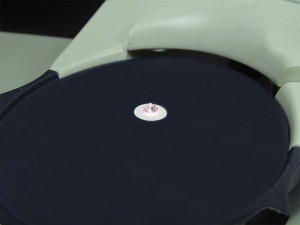 [5]
[5]With this information in mind, it is possible to use the diamond’s fluorescence as a key screening tool for separating natural and synthetic. Using a Type II spotter and ultraviolet light that emits in short- and long-wave, it is possible to separate ambiguous diamonds from their natural counterparts.
A Type II spotter is a piece of handheld equipment featuring a viewing chamber coated with a highly fluorescent substance. By placing a short-wave ultraviolet light source against a diamond mounted inside the device, the user can see whether the light is being transmitted through the stone and onto the reactive surface. When the diamond is a Type IIa, the surface fluoresces and the stone can be flagged as a possible CVD or HPHT synthetic, an HPHT-treated natural diamond, or a naturally occurring Type IIa diamond.
For those diamonds viewed through the Type II spotter that don’t react, two possibilities exist: a natural Type I diamond or an HPHT synthetic. Next, view these diamonds under short- and long-wave ultraviolet light to observe their reaction. If the diamond fluoresces blue, it is natural. If it fluoresces any colour other than blue, observe whether the intensity of the colour under ultraviolet light changes as short- and long-wave UV light are applied. If no change is observed or the colour intensity is at its strongest under long-wave UV, the diamond is also natural.
Lab-grown diamonds exhibit an increase in intensity in the reverse order, or more accurately described, the colour is stronger under short-wave UV than long-wave. When a diamond exhibits an afterglow (i.e. it continues to fluoresce after short-wave UV light has been removed), this is called ‘phosphorescence’ and its presence confirms the stone is lab-grown. Diamonds remaining inert throughout should be noted as ambiguous and sent for further testing.
 [6]
[6]The next phase of differentiation occurs during the growth of crystal structures, making it one of the most significant features imparted onto a diamond. As mentioned previously, diamonds are formed in the earth’s crust over the course of hundreds of billions of years; the rate of growth is extremely small and the pressures exerted are immense. This is the key feature one proprietary detector uses to identify lab-grown diamonds. With natural diamonds, changing temperatures and pressures result in a growth pattern that is quite erratic and random, and is observed as a spider web pattern throughout the stone when viewed through this particular detector.
With HPHT lab-growns, the initial diamond seed is placed in the middle of the anvil where four pistons exert very high constant pressure under very high stable temperatures. The result is a crystal exhibiting a telltale cross pattern that can also be easily viewed with this proprietary technology. CVD diamonds, on the other hand, are a result of layers of carbon atoms precipitating on a carbon seed plate, allowing for the seed plate or individual growth layers to be observed in some cases.
Though these attributes can be sometimes observed under magnification—in particular, the layering characteristic of CVD diamonds—technology exists that is better suited to identify these features.
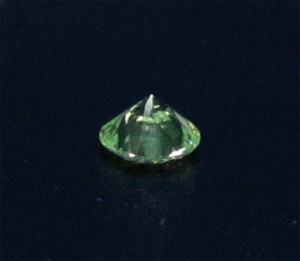 [7]
[7]The last phase in differentiation occurs as a result of the environment in which the diamond crystal grows. In the case of naturally occurring diamonds, remnants of the environment are often found within the stone and, in some cases, they are included crystals of smaller diamonds or gemstones. With the use of high magnification, these foreign objects can be easily identified and would clearly prove the diamond’s natural origin. In the case of CVD stones, there are no foreign impurities that can contaminate the crystal due to the high concentration of carbon gas precipitated onto a diamond seed in the growing chamber. The only defect that does occur is graphite crystallization within the diamond crystal, since the temperature at which the CVD process occurs is ideal for graphite growth. As for HPHT diamonds, impurities are always metallic in nature and are the result of contamination from metal flux, which is the carrier of a colouring or colour-removing agent added to the initial ingredient. Once the HPHT process begins, the metal flux separates from the agent and reforms as metallic inclusions within the diamond crystal.
It would appear companies that make synthetic diamonds are coming on strong in pitching their product to the trade. In fact, at the time of this article’s writing, I had just received an e-mail from a manufacturer advertising small lab-grown diamonds for sale at JCK Las Vegas. Though it may appear the issue of synthetic diamonds is being addressed by major diamond manufacturers and dealers with varying results, I would suggest based on the findings of my colleague, Isaac Mimar, outlined here[8], that undisclosed lab-growns are indeed in secondary markets like Canada. The question remains, what will we do as an industry to ensure the natural diamond pipeline remains unpolluted of undisclosed synthetics?
 [9]Hemdeep Patel is head of marketing and product development of Toronto-based HKD Diamond Laboratories Canada, an advanced gemstone and diamond laboratory with locations in Bangkok, Thailand, and Mumbai, India. He also leads Creative CADworks, a 3D CAD jewellery design and production firm. Holding a B.Sc. in physics and astronomy, Patel is a third-generation member of the jewellery industry, a graduate gemmologist, and vice-president of the Ontario chapter of the GIA alumni association. Patel can be contacted via e-mail at hemdeep@hkdlab.ca[10] or sales@creativecadworks.ca[11].
[9]Hemdeep Patel is head of marketing and product development of Toronto-based HKD Diamond Laboratories Canada, an advanced gemstone and diamond laboratory with locations in Bangkok, Thailand, and Mumbai, India. He also leads Creative CADworks, a 3D CAD jewellery design and production firm. Holding a B.Sc. in physics and astronomy, Patel is a third-generation member of the jewellery industry, a graduate gemmologist, and vice-president of the Ontario chapter of the GIA alumni association. Patel can be contacted via e-mail at hemdeep@hkdlab.ca[10] or sales@creativecadworks.ca[11].
- [Image]: http://www.jewellerybusiness.com/wp-content/uploads/2015/11/bigstock-Golden-Engagement-Ring-with-Di-67574329.jpg
- [Image]: http://www.jewellerybusiness.com/wp-content/uploads/2015/11/IMG_0559.jpg
- [Image]: http://www.jewellerybusiness.com/wp-content/uploads/2015/11/IMG_0533.jpg
- [Image]: http://www.jewellerybusiness.com/wp-content/uploads/2015/11/IMG_2750-edit-1.jpg
- [Image]: http://www.jewellerybusiness.com/wp-content/uploads/2015/11/IMG_0560.jpg
- [Image]: http://www.jewellerybusiness.com/wp-content/uploads/2015/08/IMG_0568.jpg
- [Image]: http://www.jewellerybusiness.com/wp-content/uploads/2015/08/IMG_0561.jpg
- outlined here: http://www.jewellerybusiness.com/?p=16688
- [Image]: http://www.jewellerybusiness.com/wp-content/uploads/2015/05/Hemdeep-Patel-e1448553068667.jpg
- hemdeep@hkdlab.ca: mailto:hemdeep@hkdlab.ca
- sales@creativecadworks.ca: mailto:sales@creativecadworks.ca
Source URL: https://www.jewellerybusiness.com/features/how-certain-clues-can-help-weed-out-synthetics-from-natural-diamonds/